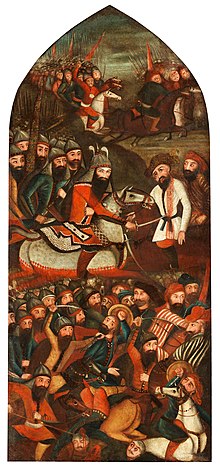Khosrow Soltan Armani, also known as Khosrow Khan (died 1653), was a Safavid official, military commander, and gholam of Armenian origin. He held numerous posts at various times. First, he served as the prefect of the Bakhtiari tribe for a lengthy period (darughah-ye il-e Bakhtiyar). Then, he served as a steward of the Javanshir tribe in Karabagh (hakem-e il-e Javanshir). Later, he held the post of "master of the hunt" (mīr shekār-bāshi) and was given the governorship of Abhar (Soltaniyeh). Lastly, he also served as the governor (beglarbeg) of Shirvan from 1643 to 1653. During his governorship in Shirvan, Khosrow participated in the successful Safavid offensive during the Russo-Persian War of 1651–1653, which resulted in the Russian fortress on the Iranian side of the Terek River being destroyed and its garrison expelled.
Khosrow Soltan Armani | |
|---|---|
 Qajar-era painting, perhaps anachronistically depicting the Iranian victory over the Russians in the 1651–1653 war. The Iranian figure in the center likely represents Khosrow Khan, depicted as both a Qajar prince and a mytho-historical hero of the Shahnameh. The opposing Russian forces, dressed in antiquated and provincial-style clothing, likely represent local troops from the North Caucasus | |
| Governor of Shirvan | |
| In office 1643–1653 | |
| Preceded by | Arab Khan Shamlu |
| Succeeded by | Najafqoli Khan Cherkes |
| Governor of Abhar (Soltaniyeh) | |
| In office before 1642 – Unknown | |
| Preceded by | Safiqoli Khan Begdeli |
| Succeeded by | Safiqoli Beg |
| Master of the hunt (mīr shekār-bāshi) | |
| In office 1632–1645 | |
| Preceded by | Qujeh Beg |
| Succeeded by | Allahverdi Khan (Armenian) |
| Personal details | |
| Died | 1653 |
| Children | Allahverdi Khan (Armenian) and Emamverdi Beg |
| Occupation | Military leader, official |
| Military service | |
| Allegiance | |
| Battles/wars | Russo-Persian War of 1651–1653 |
To denote that he was a convert, in the then contemporary sources Khosrow was referred to as being "new to Islam" (jadid ol-eslam). His sons Allahverdi Khan (not to be mistaken with the Georgian Allahverdi Khan) and Emamverdi Beg would hold several influential positions as well.
Sources
edit- Baghdiantz-McCabe, Ina (2008). "Caucasian Elites and Modern State-Building in Safavid Iran". In Chaudhury, Shushil; Kévonian, Kéram (eds.). Les Arméniens dans le commerce asiatique au début de l'ère moderne. Maison des Sciences de l'Homme. p. 99. ISBN 978-2735112043.
- Fleischer, C. (1985). "ALLĀHVERDĪ KHAN (2)". Encyclopaedia Iranica, Vol. I, Fasc. 8. p. 892.
- Floor, Willem (2001). Safavid Government Institutions. Costa Mesa, California: Mazda Publishers. p. 117. ISBN 978-1568591353.
- Floor, Willem M.; Faghfoory, Mohammad H. (2007). The Dastur Al-moluk: A Safavid State Manual, by Mohammad Rafi' al-Din Ansari. Mazda Publishers. pp. 187–188. ISBN 978-1568591957.
- Floor, Willem M. (2008). Titles and Emoluments in Safavid Iran: A Third Manual of Safavid Administration, by Mirza Naqi Nasiri. Washington, DC: Mage Publishers. pp. 209, 286–287, 292. ISBN 978-1933823232.
- Matthee, Rudolph P. (1999). The Politics of Trade in Safavid Iran: Silk for Silver, 1600-1730. Cambridge: Cambridge University Press. pp. 120, 169. ISBN 978-0521641319.
- Matthee, Rudi (2012). Persia in Crisis: Safavid Decline and the Fall of Isfahan. I.B.Tauris. p. 122. ISBN 978-1845117450.
- Matthee, Rudi (2012). "Facing a Rude and Barbarous Neighbor: Iranian Perceptions of Russia and the Russians from the Safavids to the Qajars". In Amanat, Abbas; Vejdani, Farzin (eds.). Iran Facing Others: Identity Boundaries in a Historical Perspective. Palgrave Macmillan. p. 104. ISBN 978-1137013408.